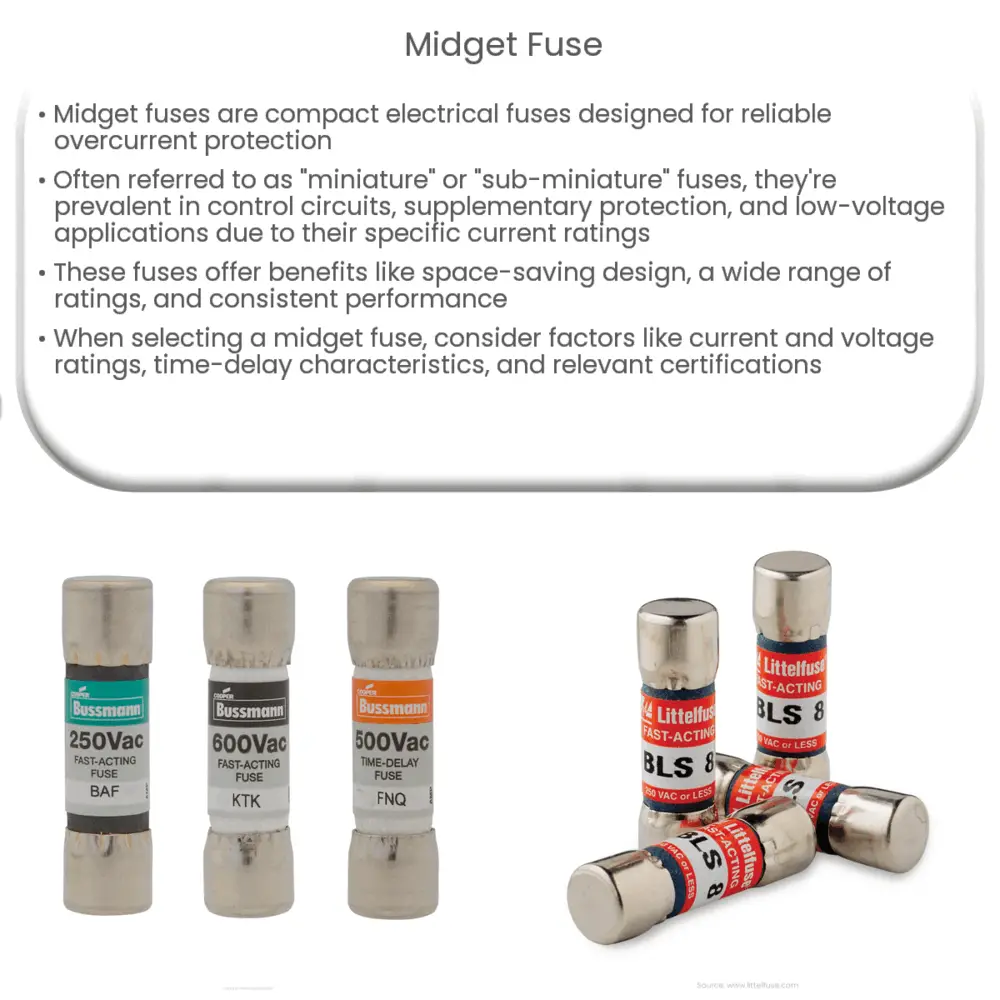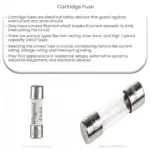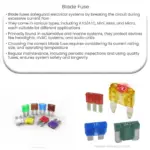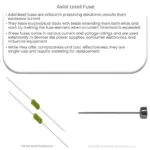Midget fuses are compact, cylindrical electrical fuses designed for overcurrent protection in control circuits, low-voltage devices, and as supplementary protection.

Midget Fuses: Understanding Their Purpose and Applications
Midget fuses are a specialized type of electrical fuse, designed to provide reliable overcurrent protection in a compact form factor. These fuses are commonly used in control circuits and various electronic devices due to their small size and precise current ratings. This article will delve into the purpose, applications, and benefits of midget fuses, as well as how to choose the right midget fuse for your needs.
What are Midget Fuses?
Midget fuses, also referred to as “miniature” or “sub-miniature” fuses, are small, cylindrical fuses that provide overcurrent protection for various electrical devices and systems. They are typically found in control circuits, supplementary protection, and low-voltage applications. Midget fuses are available in a wide range of current ratings, voltage ratings, and time-delay characteristics, making them suitable for a variety of applications.
How Do Midget Fuses Work?
Like all fuses, midget fuses work by providing a weak link in an electrical circuit that will break when excessive current flows through it. The fuse contains a thin conductive element, often made of metal alloy, which is designed to melt when exposed to a current above its rated capacity. This melting process interrupts the flow of current, protecting the circuit and its components from damage due to overcurrent or short-circuits.
Applications of Midget Fuses
Midget fuses are commonly used in a wide range of applications, including:
- Control circuits: Midget fuses are often found in control circuit applications, where they protect sensitive electronic components from damage caused by overcurrent or short-circuit events.
- Supplementary protection: Midget fuses can be used as supplementary protection devices, providing additional overcurrent protection to complement primary protection devices like circuit breakers and other larger fuses.
- Low-voltage applications: Due to their compact size and precise current ratings, midget fuses are ideal for use in low-voltage applications such as lighting circuits, telecommunications equipment, and small appliances.
Benefits of Midget Fuses
Some of the key benefits of using midget fuses in your electrical system include:
- Compact size: Midget fuses are designed to be small and compact, making them suitable for use in tight spaces and applications where space is at a premium.
- Wide range of ratings: Midget fuses are available in a broad range of current and voltage ratings, allowing for their use in a variety of applications and ensuring that you can find the right fuse for your specific needs.
- Fast-acting and time-delay options: Midget fuses can be either fast-acting or time-delay, allowing you to choose the best option for your application based on the desired response time to overcurrent events.
- Reliable performance: Midget fuses are designed to provide consistent and reliable overcurrent protection, helping to prevent damage to your electrical system and its components.
Choosing the Right Midget Fuse
To select the appropriate midget fuse for your application, consider the following factors:
- Current rating: Choose a midget fuse with a current rating that matches the maximum current your device or circuit can safely handle. This rating should be slightly higher than the normal operating current to prevent nuisance tripping.
- Voltage rating: Ensure that the midget fuse has a voltage rating equal to or greater than the maximum voltage your system will experience. Using a fuse with a lower voltage rating may result in inadequate protection.
- Time-delay characteristics: Select a midget fuse with the appropriate time-delay characteristics based on your application’s needs. Fast-acting fuses offer quick response times to overcurrent events, while time-delay fuses allow for temporary inrush currents without tripping.
- Physical size and dimensions: Verify that the midget fuse’s dimensions are compatible with your device or fuse holder, ensuring proper fit and function.
- Standards and certifications: Choose a midget fuse that complies with relevant industry standards and certifications, such as UL, CSA, or IEC, to ensure the fuse’s quality and performance.
Replacing a Midget Fuse
When a midget fuse has served its purpose and protected your equipment, it will need to be replaced. To replace a midget fuse, follow these steps:
- Disconnect power from the device or circuit to ensure safety.
- Identify and locate the blown midget fuse. This may involve opening the device or accessing the fuse holder on a control panel.
- Remove the blown fuse carefully, avoiding contact with other components or wiring.
- Verify the ratings and dimensions of the replacement fuse, ensuring it matches the original fuse.
- Insert the new midget fuse into the fuse holder or device, ensuring proper seating and alignment.
- Reconnect power and test the device or circuit to ensure proper function and protection.
Conclusion
Midget fuses provide reliable overcurrent protection in a compact form factor, making them ideal for a variety of applications, including control circuits, supplementary protection, and low-voltage devices. By understanding their purpose, applications, and benefits, as well as how to choose the right midget fuse for your needs, you can ensure the safety and longevity of your electrical systems and devices.




